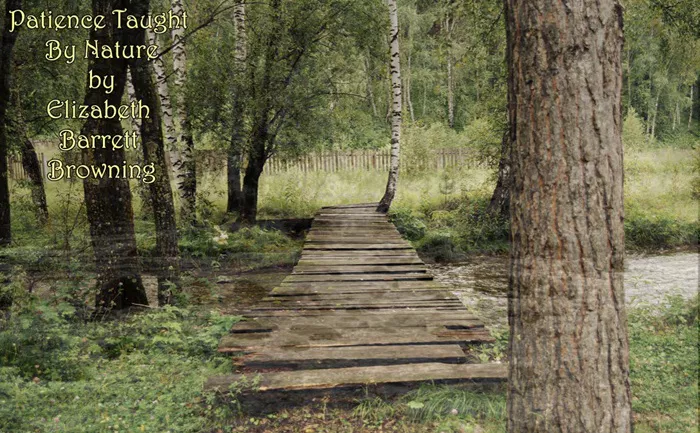Welcome to Poem of the Day – Patience Taught by Nature by Elizabeth Barrett Browning.
Elizabeth Barrett Browning, a renowned Victorian poet, is best known for her emotional depth and intellectual prowess. One of her poems, Patience Taught by Nature, reveals her reflections on the theme of patience. Through her careful use of language and imagery, Browning portrays the natural world as a teacher of patience. In this article, we will explore the meaning and message of the poem, explaining how Browning connects the human experience with the rhythms of nature.
Patience Taught by Nature Explanation
The Setting of the Poem
Browning’s Patience Taught by Nature is set in the natural world, where the speaker contemplates the way nature operates—slowly, quietly, and persistently. The poet uses nature’s cycles to suggest that patience is not just a virtue but a necessity. As we observe nature’s processes, from the growth of plants to the movement of time, we begin to see how patience is woven into the fabric of the universe.
Meaning and Themes
The primary theme of Patience Taught by Nature is the virtue of patience. Browning suggests that nature, with its slow-moving and often imperceptible changes, teaches us the value of enduring hardship without haste. Through the cycles of seasons, the patient unfolding of a flower, and the steady rhythm of life, we are reminded that true growth and understanding come with time.
The poem encourages readers to adopt a patient attitude toward life’s challenges. In a world often obsessed with instant results, Browning offers a contrasting view—one that values the quiet, slow-moving, and steady progress of nature. Just as plants grow in their own time, we, too, must wait for our own personal development and healing.
Browning’s Use of Nature
Browning draws on the imagery of nature to create a vivid picture of how patience is taught. The poet compares life’s difficulties to a gardener waiting for seeds to sprout. There is no rushing this process. Nature’s law is that growth takes time, and so does emotional and personal growth.
She also uses the imagery of seasons—particularly winter and spring—to highlight the contrasts between waiting and renewal. In winter, everything seems dormant, yet beneath the surface, change is happening. This is a key message of the poem: even when things seem still, patience ensures that growth and progress will eventually occur.
Symbolism of Nature
Nature in Browning’s poem becomes a symbol of wisdom. It shows us that patience is not passive resignation but an active waiting for the right moment. Through its cycles, nature teaches that all things have their time, and waiting does not mean stagnation. It means trusting that change is coming, even when we cannot yet see it.
Language and Structure
Browning’s language is simple, yet it carries deep meaning. She uses natural imagery that is easy to visualize—such as flowers, trees, and seasons—which makes her message accessible to all readers. The structure of the poem is also reflective of its theme. It is composed in short, clear stanzas, reinforcing the idea that patience requires us to take small, deliberate steps.
Conclusion
Patience Taught by Nature is a beautiful reflection on how patience is not simply a personal trait but a lesson that nature teaches us every day. Browning uses the imagery of the natural world to highlight how patience, though often difficult, is essential for growth and understanding. Through her poem, she reminds us that just as nature has its rhythms, so must we learn to move with the flow of time. By being patient, we allow ourselves the opportunity to grow, change, and, ultimately, flourish.

